Access to technology and capital determines the success of any enterprise, which includes farming. But technologies — improved seeds, irrigation, farm machinery, etc. — can to a great extent be acquired, if farmers have access to capital. And that is an area of major concern for most farmers: Since lack of collateral dents their ability to obtain loans from banks, they borrow at 24-72 per cent annual interest from informal credit markets. It, then, renders their enterprise unviable.
 |
| Image courtesy : staticflickr.com |
It raises a basic question: Why don’t farmers get their land properly registered? One reason, of course, the high stamp duties for registration, averaging 6-7 per cent and ranging from 4 per cent in Maharashtra to 14.5 per cent in Uttar Pradesh. This is where a policy initiative by Telangana promises to open up opportunities for millions of suffering farmers. The government of the newly created state, in June, opened a three-week window allowing farmers to register free-of-cost the land they may have bought in the past based on hand-written notes, locally known as ‘sada bainama’. These informal sale documents confer no real legal ownership entitling their holders to seasonal agricultural loans from banks or government compensation against crop losses. The Telangana government’s announcement led to over 1.1 million applications from farmers flocking to get their plain paper-based land purchase transactions formally registered.
The Telangana example is definitely worthy of emulation by other states. But the objective should not be to just provide legal titles to land. Rather, it must aim at complete digitisation of land records. Each land parcel registered should be located through a GIS marker, seeded with the owner’s Aadhaar details and fixed on a digital map. The process would culminate in assigning a unique identity — call it a Land Identity Number or LIN — for each such parcel. From there, the next step is to integrate LIN to JAM (i.e. the farmer’s Jan Dhan bank account, her Aadhaar unique identification and Mobile numbers).
A farmer’s LIN can further be linked to a data server that would have details of which crop she is cultivating on the particular plot. The farmer can herself provide that information to the server by simply sending an SMS. Geography-specific weather aberrations can, then, be monitored and crop production estimates revised in real time. With a planned grid of weather stations, it is possible to also implement a foolproof crop insurance scheme. The LIN enables each farmer to be tagged to the nearest weather station. If the station indicates a bad weather event (drought or excess rain), there could be a system-generated signal to the insurance company to process the agreed compensation to the farmer’s Aadhaar-seeded bank account within 24-48 hours.
Crop loans can similarly be processed smoothly with minimal formalities, once banks have the LIN and JAM details of all farmers. With the LIN-JAM confluence making available the details of the plot of land and credit history of each farmer, no further document is required for processing such loans. Eventually, there could even be credit information bureaus providing credit rankings for individual farmers against their LINs. A model more or less on these lines is, in fact, currently being piloted in both Telangana and Andhra Pradesh. Hopefully, it should yield something bigger that is also replicable on a national scale.
LIN can, moreover, provide a potential solution to the tricky subject of land tenancy in India. Land, we know, is a sensitive and emotional subject. With LIN and digitisation of land records, however, owners can be assured that their ownership rights are protected. Matching the Aadhaar details of the landowner and tenant with LIN makes it possible to also create a record of tenancy. That, in turn, would help the government to crack the puzzle associated with moving from the existing system of non-targeted agricultural input subsidies to making direct cash transfers. Right now, in the absence of identification of the real tiller of the land, there is the danger of such transfers being made to unintended recipients. All this will change once tenancies are legalised through simultaneous protection of landowners’ rights.
LIN will also enable land aggregation, ushering in economies of scale in agriculture. With secure titles and replacement of physical boundaries by digital ones, there would be incentives for pooling and creation of larger land parcels, on which advanced farm machinery technologies can be deployed. Use of planters and harvesters can pare cultivation costs by 15-30 per cent, just as laser leveling machines could help boost yields by 10-15 per cent and reduce water requirement by 20-30 per cent. Operating these is not really possible today on small, fragmented plots. The overall increase of up to 50 per cent in incomes of farmers — from productivity gains and reduced costs of cultivation, not to speak of improved access to capital, crop insurance and government transfers — would mark a significant step towards realising the Prime Minister’s goal of “doubling farm incomes by 2022”. Aggregation of output from economies of scale will also help agribusiness companies to directly source produce from farmers.
The LIN solution can be a transformative initiative that leads to ease of doing business for all stakeholders in agriculture — farmers, traders/processors, bankers, insurance companies and the government itself. The costs of putting up the infrastructure for digitisation on such a scale is negligible compared to the gains to be made in the short and medium term. For India’s IT giants, too, it serves as a challenge and opportunity to make a difference — in a field where they have hardly worked.
courtesy : The Indian Express
No comments:
Post a Comment